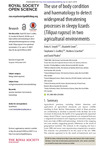The use of body condition and haematology to detect widespread threatening processes in sleepy lizards in two agricultural environments.
| dc.contributor.author | Smyth, Anita K. | en_US |
| dc.contributor.author | Smee, Elizabeth | en_US |
| dc.contributor.author | Godfrey, Stephanie S. | en_US |
| dc.date.accessioned | 2016-07-18T06:49:10Z | |
| dc.date.available | 2016-07-18T06:49:10Z | |
| dc.date.issued | 2014 | en_US |
| dc.identifier.other | HPU4160446 | en_US |
| dc.identifier.uri | https://lib.hpu.edu.vn/handle/123456789/22290 | en_US |
| dc.description.abstract | Agricultural practices, including habitat alteration and application of agricultural chemicals, can impact wildlife resulting in their decline. Determining which of these practices are contributing to declines is essential if the declines are to be reversed. In this study, the health of two geographically separated sleepy lizard (Tiliqua rugosa) populations was compared between a rangeland environment and cropping environment using linear body size index (LBSI) and haematology. Animals in the cropping site were smaller, suggesting genetic differences as the result of geographical isolation. | en_US |
| dc.format.extent | 13 p. | en_US |
| dc.format.mimetype | application/pdf | en_US |
| dc.language.iso | en | en_US |
| dc.subject | Biology | en_US |
| dc.subject | Ecology | en_US |
| dc.subject | Environmental science | en_US |
| dc.subject | Microbiology | en_US |
| dc.subject | Anaemia | en_US |
| dc.subject | Haemolysis | en_US |
| dc.subject | Farm chemicals | en_US |
| dc.subject | Haematology | en_US |
| dc.title | The use of body condition and haematology to detect widespread threatening processes in sleepy lizards in two agricultural environments. | en_US |
| dc.type | Article | en_US |
| dc.size | 748KB | en_US |
| dc.department | Education | en_US |
Files in this item
This item appears in the following Collection(s)
-
Education [806]

